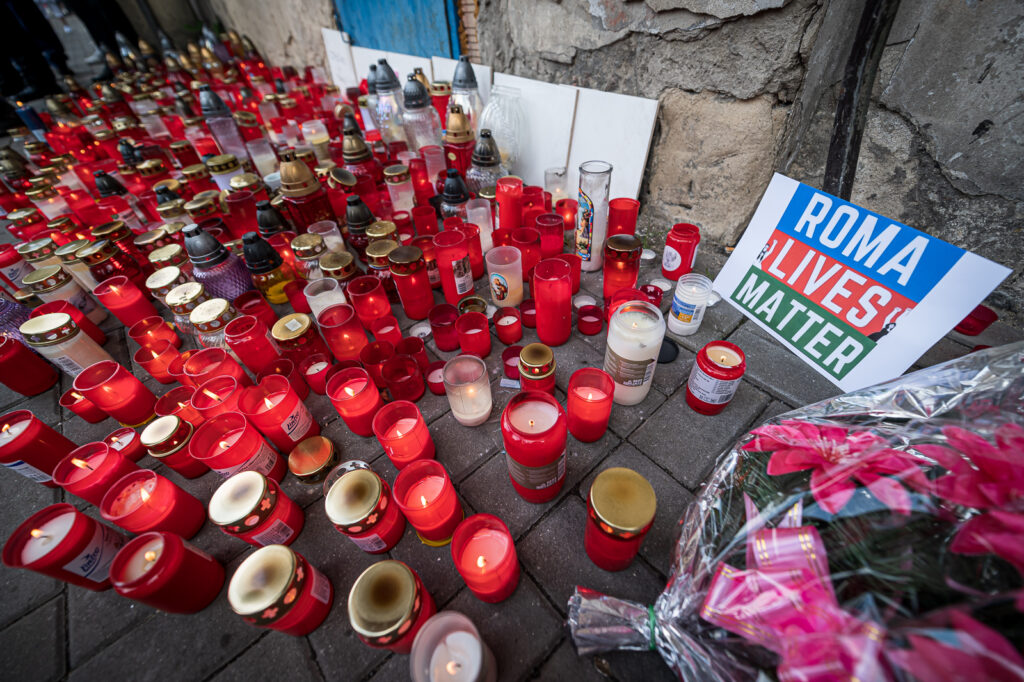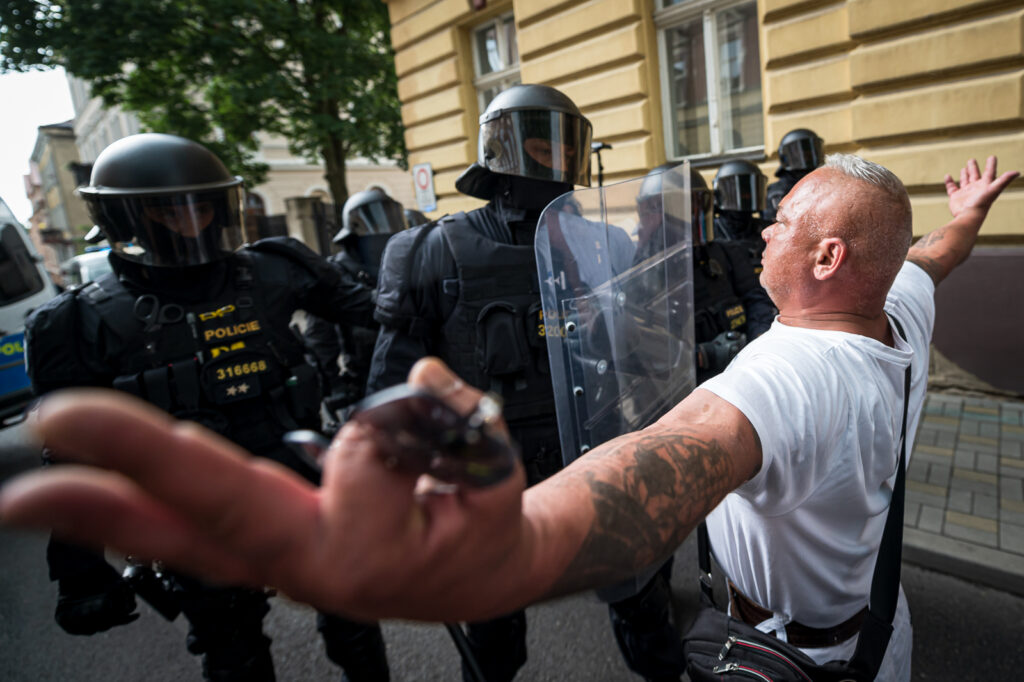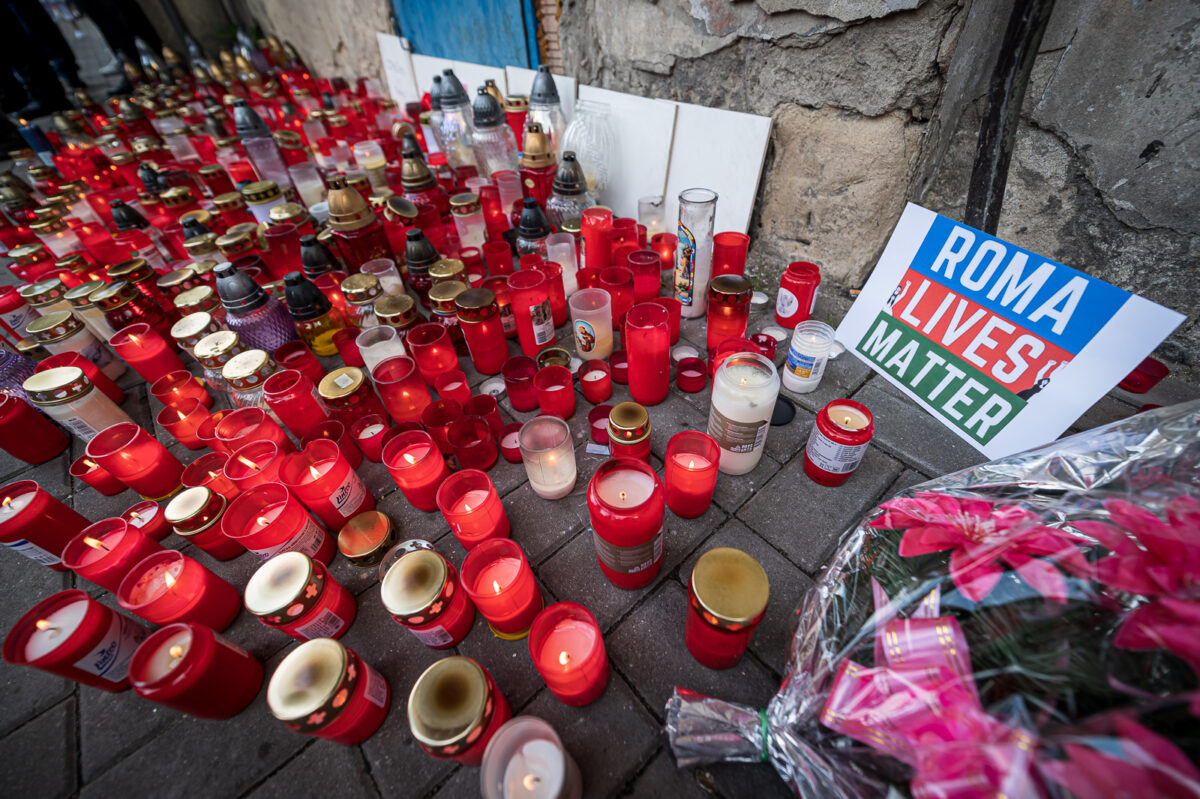On the 19th of June, video footage of a police officer kneeling on the neck a cuffed Roma man named Stanislav Tomáš in the City of Teplice, Czech Republic, was published. Although the original video was removed, various media outlets reposted parts of it the next day. Tomáš’s death, as well as the footage portraying the police’s brutal use of violence during the arrest, outraged Roma communities in Europe. Kneeling on a person’s neck, a practice implemented by police officers across the world, has in the recent period become a symbol of police brutality and has started many conversations on the intertwined nature of police violence and racism. Furthermore, while reporting on the incident, some media and NGOs still do not mention the name of the departed Tomáš while underlining similarities with the George Floyd Case. Therefore, we ask: Does the oppression of Roma need to be told as part of another narrative in order to trigger empathy and solidarity? Why does the Czech society keep thinking of and treating its citizens of Roma origin as the Other and finally, which socio-political mechanisms are hindering the access of Roma to justice?

As mentioned, NGOs and media rushed to report on this incident without naming the victim. Perhaps this could be ascribed to the NGO-ization phenomenon, which made Roma into nameless project beneficiaries without the right to claim a personal name or expect personalized storytelling. Even in pain, Roma people remain nameless and invisible, because the racialized assumptions about Roma prevail to this day. To challenge the dominant narrative about Roma as non-deserving of empathy and solidarity, the Roma victim must be part of another, more acceptable, more familiar narrative. Stanislav Tomáš had to become the Roma Floyd so that the readership/spectatorship could empathize. Comparing Stanislav Tomáš to George Floyd, while making no effort to say his name seems to be the only way to keep the public engaged in learning about yet another case of police brutality against Roma.
Stanislav was allegedly intoxicated and violent, requiring police intervention. However, it remains unclear why this intervention required the kneeling manoeuvre. Stanislav was already cuffed with his hands behind his back, yet the policemen kneeled on his neck and pressed his body to the concrete for several minutes. Kneeling on the suspect is an instrument allowed by the Czech police regulation, however, its overall implementation remains vague and subject to interpretation. Namely, police authorities have not yet explained how they decide if kneeling is needed (especially when the suspect is cuffed), or what the maximum amount of time is that a police officer can kneel on a suspect without endangering their life. These ambiguities, in addition to continuous anti-Roma racism fueled by statements from the political establishment, have led the Roma community to ask: why is it that when it comes to police interventions which include Roma people, the police resorts to such drastic, violent measures that endanger the arrested subject and add greater tension to the police intervention? Is it because the police officers expect the Roma to be more dangerous and less predictable than non-Roma subjects? This could be the case, given the widespread vilification of Roma through accustomed stereotypes. It can also be assumed that Roma subjects act in fear when confronted with police authorities. Roma collective memory includes stories of state persecution; there is intergenerational trauma and consequently a lack of trust, caused by the authorities’ continuous malevolence who frequently and openly express(ed) their anti-Roma racism.
While writing this article we have contacted multiple Roma who were present at the scene in hopes they would share a testimony with us. None of them were ready to officially state what they had witnessed to any state authority, underlining that they are afraid of potential retaliation for speaking up. Following the incident and vocal comparisons with George Floyd’s murder, police authorities released video footage of an enraged man, claiming that it shows Tomáš prior to being arrested. This video served to support police claims that Tomáš was a drug addict acting in rage, therefore justifying police brutality. Simona Tomášova, Stanislav Tomáš’s sister stated that the man on the video does not match her brother’s physical appearance, adding further suspicion to an already entangled case.

Moreover, the original video in which the police officer is kneeling on Tomáš’s neck, shows Tomáš as already immobile after six minutes, leading the Roma community to believe that Tomáš died while in police custody, and as a direct result of this brutal manoeuvre. However, the police denies this and instead claims that Tomáš died in the ambulance due to heart damage caused by amphetamine abuse. In addition, the police has not addressed questions underlining the relation between pressing a person’s face/neck to the ground and subsequent limited lung function, which is a relation that – as lidovky.cz reports – has been confirmed by the Journal of Medicine, Science and Law. It should be further noted that, although the CNN Prime experiment shows that oxygenation saturation remains at a stable level during the average conditions of the kneeling manoeuvre, not all bodies can be expected to react in the same way. Therefore, kneeling may not affect all subjects in the same manner and is thus not just a violent but a life-threatening manoeuvre, which if implemented requires caution and limitations in the length of performance and strength applied. It remains unclear why the police would use the kneeling manoeuvre on a man who is already cuffed, especially if he is intoxicated, and thus endanger his life further by preventing him from breathing for several minutes. Additionally, even if it was the case that Stanislav Tomáš was struggling with drug addiction, there is still no justification for shaming a citizen or labeling them in this way, unless aiming to justify police violence or hide its consequences. Finally, ERRC reports that Tomáš family has recently filed a complaint against the Czech police.
The lack of trust between the Roma and state authorities is a result of a historical build-up of mistreatment and continuous persecution of Roma. For Roma in the Czech Republic, the suffering did not end with the defeat of Nazis, as the communist regime continued implementing some of the practices prompting the subordination of Roma. The transition period achieved the same result; it kept anti-Roma racism alive and thriving. Even after joining the EU, one can still witness racism, stretching from everyday jokes about Roma to attacks on Roma children while attending a summer camp, and in the form of the neglect of Roma by state authorities. Forced sterilization (practiced until 2007); segregation in schools; employment discrimination; these all show that human rights for Roma remain violated and Roma remain vilified. A simple activity such as renting a flat is a challenge as your Romani last name is nothing but a synonym for trouble. The abhorrent stories about untrustworthy, antisocial Roma have become part of the public discourse, with prominent political figures such as President Miloš Zeman asserting that Roma are lazy. Police brutality is one among many racist practices currently violating the dignity of Roma. It is our body, individual and social body, that suffers as police brutality creates more space for a society of fear and a state of visible violence that works together with the invisible violence in the form of state negligence – tools of systemic racism.
Czech authorities have praised this police intervention in the recent days. The Minister of Interior, Jan Hamáček, expressed his support to the police force, stressing that Tomáš was intoxicated and violated the law, further adding that the acts of the Czech police have made the Czech Republic into one of the safest countries in the world, thus justifying violence as a necessity in service of safety. Prime minister Andrej Babiš emphasized that Tomáš was aggressive and that a decent person would not end up in that situation while commending the police forces for their work, which he described as not easy, therefore once again smearing the public image of deceased Tomáš and attributing leverage to the police intervention as an unavoidable action serving public safety at large. These statements show the continuation of the narrative of urgency to discipline the supposedly unruly Roma in order to bring social and economic security to Czech society, leaving us with no time, space nor authority (at) which we could ask: aren’t Roma part of the Czech society as well? In a society where Roma are perceived as the Other and depicted as a threat to the rule of law, politicians do not shy away from anti-Roma statements as a means of securing the popular vote. Given the upcoming elections this fall, populism is surely on the rise, which for the Czech citizens of Roma origin means greater exposure to structural, everyday racism under the patronage of state authorities.
In order to bring justice to the Roma community, Czech authorities should start with a public recognition of the atrocities and everyday racist acts continually committed against the Roma. Furthermore, Czech state authorities should stop referring to this and similar cases as isolated incidents which were caused by the Roma and must show accountability for their actions. An independent investigation of Stanislav Tomáš’s case, in particular, could be the starting point of rebuilding trust. While verbal condemnation and independent investigations of similar cases are a must (and would potentially not only contribute to institutions’ impartiality, but also to securing the rule of law, hence providing some justice to the Roma community), the question of combating structural anti-Roma racism remains unresolved.
Anti-Roma racism is not endemic to the Czech Republic, as it can be observed in other EU member states. The European Commission responds to reprehensible behavior of these states (be it the founding members such as France or later enlargement wave countries – usually referred to as backsliding democracies) either through silence or in the form of verbal condemnation, without devising a proper mechanism of securing Roma rights. At the same time, the EU underlines Roma inclusion as part of the EU accession process for the aspiring members such as the six Western Balkan countries and Turkey. On the one hand, aspiring members accuse the EU of employing double standards against them. On the other hand, such requirements also create advocacy opportunities for the Roma, who struggle to remain high on the political agenda. Furthermore, in recent days, Russia (who is not an exception when it comes to anti-Roma racism and is a in diplomatic feud with the Czech Republic) has been vocal about the Stanislav Tomáš case, while the Von der Leyen Commission responded by referring to the EU’s silent policy when it comes to commenting on any ongoing investigations. Therefore, justice for Roma remains trapped within the realm of occasional token gestures, which serve to add leverage to different international actors in their ongoing international disputes; and to enable coercive diplomacy, as to induce compliance of other actors with standards to which they themselves do not fully adhere.
This forces the Roma – as Europe’s largest transnational minority of estimated 10-12 million people – to rely on the IOs and NGOs for protecting their(as Arendt would refer to in similar conundrums) right to have rights. The crisis of not having a proper mechanism to secure their rights and political representation has in the days following the death of Stanislav Tomáš stirred online discussions on the potential of a pan-European Roma movement as a form of resisting structural racism and state violence. The Proud Roma, Free Europe movement took the lead in this respect by publishing an open letter to the European Commission; using social media to generate transnational solidarity of Roma and potentially safeguard the national Roma movements from the debilitating effects of NGOization. While the future development of a united transnational Roma movement is yet to unfold, the need for a larger program of combating anti-Roma racism in Europe is acute. The program could potentially draw lessons from existing best practices of subverting racism and adjust them to the particularities of anti-Roma sentiments which shape the gaze of the non-Roma, including the gaze of the policemen, that results in mistreatment of Roma. It should also provide space for Roma history and culture in educational materials in order to secure recognition of Roma heritage as part of the European heritage; and enable larger participation of Roma in public administration as to secure greater visibility and participation of Roma in political decision-making processes, with the aim of dismantling the narratives of the Otherness of Roma. Finally, anti-Roma racism must be promptly addressed, because, when it comes to Roma, the largest minority in Europe, justice is catching its last breath.
Say his name: Stanislav Tomáš.

Michal Mižigár studied Romani Studies at Charles University in Prague, and currently, he is completing his master studies of Comparative History at Central European University (Budapest-Vienna). He has been for more than 10 years lecturing and attending discussions on topics such as Roma history and identity. He focuses on the post-war period of Roma history in former Czechoslovakia and Roma representation. Mižigár was a member of QUALIROM team preparing materials for the teaching of Romani language at schools. Furthermore, he has been for several years lecturing as an external lecturer at the Department of Deaf Studies at Faculty of Arts, Charles University in Prague and currently at Faculty of Education, University of South Bohemia in České Budějovice.

Nadja Greku holds a BA-Level degree in Sociology from the University of Novi Sad and is currently attending MA-level studies in International Relations at the Central European University in Vienna. Her research focus is on governmentality and securitization of Roma. For the past ten years she has volunteered with various Roma organisations in the Western Balkans region. She has also worked with the Regional Cooperation Council, supporting the implementation of regional economic integration programs underpinning the Berlin process (EU integration of Western Balkans countries), for over five years. She is currently researching the eviction of Roma during the Kosovo War of 1998-1999 with the aim of providing space for the collective memories of Kosovo Roma, as her final project for the History Dialogues course offered by Princeton University in cooperation with the CEU Romani Studies Program.

